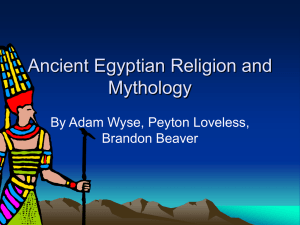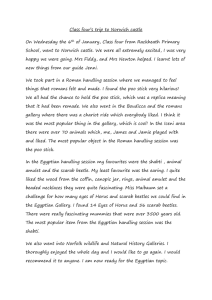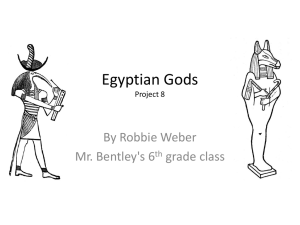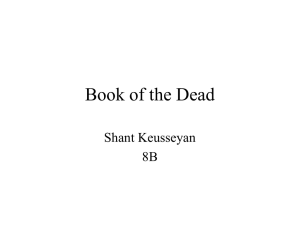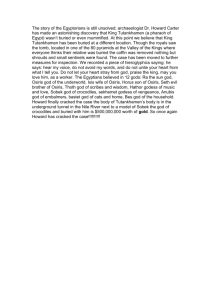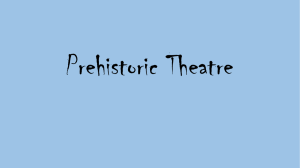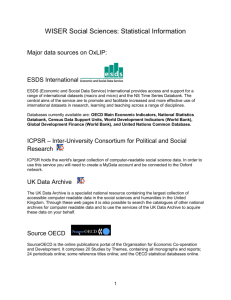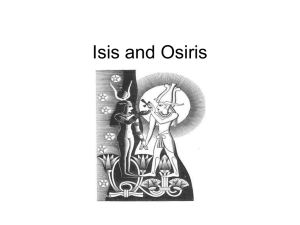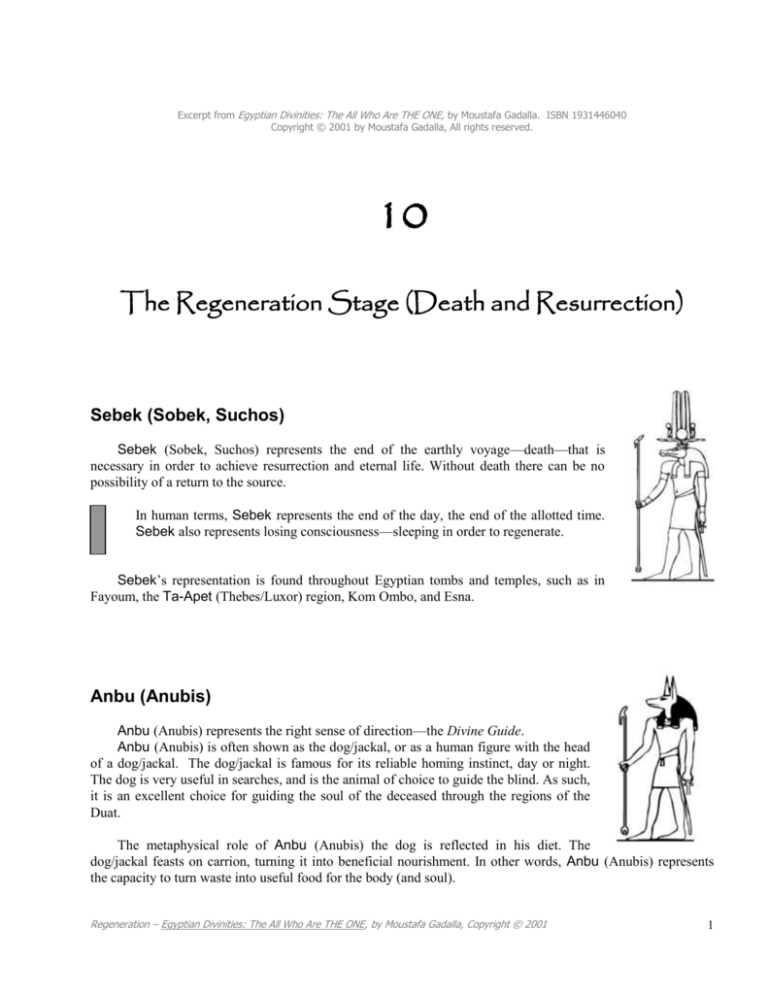
Excerpt from Egyptian Divinities: The All Who Are THE ONE, by Moustafa Gadalla. ISBN 1931446040
Copyright © 2001 by Moustafa Gadalla, All rights reserved.
10
The Regeneration Stage (Death and Resurrection)
Sebek (Sobek, Suchos)
Sebek (Sobek, Suchos) represents the end of the earthly voyage—death—that is
necessary in order to achieve resurrection and eternal life. Without death there can be no
possibility of a return to the source.
In human terms, Sebek represents the end of the day, the end of the allotted time.
Sebek also represents losing consciousness—sleeping in order to regenerate.
Sebek’s representation is found throughout Egyptian tombs and temples, such as in
Fayoum, the Ta-Apet (Thebes/Luxor) region, Kom Ombo, and Esna.
Anbu (Anubis)
Anbu (Anubis) represents the right sense of direction—the Divine Guide.
Anbu (Anubis) is often shown as the dog/jackal, or as a human figure with the head
of a dog/jackal. The dog/jackal is famous for its reliable homing instinct, day or night.
The dog is very useful in searches, and is the animal of choice to guide the blind. As such,
it is an excellent choice for guiding the soul of the deceased through the regions of the
Duat.
The metaphysical role of Anbu (Anubis) the dog is reflected in his diet. The
dog/jackal feasts on carrion, turning it into beneficial nourishment. In other words, Anbu (Anubis) represents
the capacity to turn waste into useful food for the body (and soul).
Regeneration – Egyptian Divinities: The All Who Are THE ONE, by Moustafa Gadalla, Copyright © 2001
1
Anbu (Anubis) the dog represents absolute loyalty, and as such, is depicted at the scene of the weighing of
the heart, overseeing the correctness of the procedure [see next page].
In human terms, Anbu (Anubis) represents the right sense of direction in
whatever we do, the absolute loyalty, and the capacity to turn lead (carrion) into
gold (worthiness).
Another form of Anbu (Anubis) is Ubuat or Web-wawet (Opener of the Way)—
The Divine Guide.
Ausar (Osiris), The Grand Judge
Ausar (Osiris) represents the underworld, the power of renewal, the bearer of the seed of resurrection, and
the possibility of returning to the source. The first step toward that goal is performance evaluation, which was/is
carried out in the symbolic Hall of Judgment [a partial symbolic scene below].
1 - Ma-at
2 - Anbu (Anubis)
3 - Amam (Ammit)
6 - Heru (Horus)
7 - Heru (Horus) Disciples
8 - Ausar (Osiris)
4 - Tehuti (Thoth)
9 - 42 Judges/Assessors
5 - The deceased
Performance evaluation is carried out by the 42 Assessors (jurors). The deceased is required to know
(recognize) the inner nature of each of the Assessors, and to plead innocent of committing the specific
undesirable act (sin) under the jurisdiction of that Assessor.
Regeneration – Egyptian Divinities: The All Who Are THE ONE, by Moustafa Gadalla, Copyright © 2001
2
The performance evaluation by the 42 Assessors determines the deceased’s destiny. The unperfected soul
will be reborn in another physical vehicle (body), to try again. The perfected soul will go through the process of
transformation and the subsequent rebirth. The outcome of his/her evaluation will determine which heavenly
level (2-6) a person reaches. [See more about the different levels/realms on page 22.]
In human terms, performance evaluation is actually self-evaluation of how one performs his/her
activities at work, home, play, etc. Everyone knows that the hardest judge is oneself.
[See other aspects of Ausar (Osiris) throughout the book.]
[For more information about life after earth, 42 Negative Confessions, etc, see Egyptian Cosmology: The Animated
Universe, by same author.]
Amam (Ammit, Amemet)
Amam (Ammit) represents the state of unconsciousness—the unspiritualized
human—the materialized world.
In human terms, a person with no consciousness is just a piece of meat.
Amam (Ammit) is depicted as a composite beast, awaiting the results of the
weighing of the heart in the Hall of Judgment [shown on page 101]. The heart
symbolizes consciousness. Those hearts that weigh more than the feather of truth are
thrown to Amam.
Apep/Apop (Apopis)
Apep (Apopis) is a coiled serpent—a form of Set (Seth), representing
the power of opposition to resurrection. To overcome such an opposition, the
combined forces of Ra (Re), Ausar (Osiris), and Heru (Horus) unite to
defeat Apep (Apopis).
In human terms, obstacles should be expected, dealt with, and
overcome—in order to achieve goals.
Mehen
Mehen is a coiled serpent, representing one of the forces of light,
assisting towards resurrection.
Regeneration – Egyptian Divinities: The All Who Are THE ONE, by Moustafa Gadalla, Copyright © 2001
3
Neheb Kau
Neheb Kau—meaning the provider of forms, qualities, attributes—
was the name given to the serpent representing the primordial spiral in
Ancient Egypt. Neheb Kau is depicted as a two-headed serpent,
representing the dual spiral nature of the universe.
Benben / Bennu/Benu
Benben is the symbol of the primeval hill.
In human terms, Benben represents the state of gaining consciousness, which
means standing on solid ground (in this case, a hill). One gains consciousness
when his/her soul flies back to its earthly body after a long night.
This flying bird is Benu, portrayed as a composite heron and stork, or as a
composite of the falcon and stork. Therefore, the Benu bird represents resurrection. It is
the ultimate goal of the deceased to become the Benu.
Un-Nefer (Wenen-nefer, Onnophris)
Un-Nefer (Wenen-nefer, Onnophris) means he who is continually happy, which describes the deceased,
in his/her form as Ausar (Osiris), after his/her resurrection.
Khepri
Khepri (Khepera) is the Ancient Egyptian term for the scarab beetle—a composite word meaning who
brings into being. It is a form of Ra (Re), as the rising sun.
Khepri was depicted as the scarab or as a human figure with a
scarab in place of his head. Ra (Re) is frequently represented as a large
black scarab beetle, sitting in the solar boat and rolling the sun disk, or as
a man whose human head is replaced by a scarab beetle.
Regeneration – Egyptian Divinities: The All Who Are THE ONE, by Moustafa Gadalla, Copyright © 2001
4
Horapollo Niliaeus explains the symbolism of the scarab in this way:
To signify the only begotten, or birth, or a father, or the world, or man, they [Egyptians] draw a
scarab. The only begotten, because this animal is self-begotten, unborn of the female. For its birth
takes place only in the following way. When the male wishes to have offspring, it takes some cow
dung and makes a round ball of it, very much in the shape of the world. Rolling it with its hind legs
from east to west, it faces the east, so as to give it the shape of the world, for the world is borne
from the east to the west.
In the Ancient Egyptian transformational (funerary) texts, the deceased, identified with Ausar (Osiris),
passed through analogous stages in the night of the underworld and was reborn as a new Ra (Re), in his form of
Khepri (the scarab beetle) in the morning. The analogy to the sun—disappearing at night and appearing in the
morning—is clear. The scarab is the symbol of the transforming quality of the sun, the light that becomes out of
darkness. Scarab amulets were customarily buried with the deceased to promote rebirth.
Aton/Aten
Aton is the disk of the sun as one of the physical manifestations of Ra (Re).
Aton is one of a multitude of divinities, and it was not a new idea that was
introduced by Akhenaton (1367-1361 BCE). Aton is found in Egyptian texts that go
back at least to the 12th Dynasty (1991-1783 BCE).
[Read more about Akhenaton in Historical Deception: The Untold Story of Ancient
Egypt - 2nd ed., by same author.]
Sakar (Sokar/Sokaris)
Sakar (Sokaris) represents the darkest point of night—the most inactive point of the deepest stage of the
sun’s journey beneath the earth.
Sakkara (named after Sakar) was a prominent cemetery site in Ancient Egypt, since (and probably prior to)
the time of dynastic Egypt.
Sakar is usually combined with Ptah and/or Ausar (Osiris):
– in binary form, i.e. Ptah–Sakar (Sokaris) or Sakar-Ausar (Osiris),
– or as the triad, Ptah–Sakar–Ausar, which is sometimes portrayed as a single
composite form (shown herein), incorporating the principals of creation, death, and
afterlife.
Regeneration – Egyptian Divinities: The All Who Are THE ONE, by Moustafa Gadalla, Copyright © 2001
5
The composite, Ptah–Sakar–Ausar, is usually depicted as a hawk-headed male figure, bound in
swaddling clothes, similar to Ptah.
Aker
Aker represents the voyage from life to death, east to west, yesterday to tomorrow.
Aker is depicted in pure lion form
or as a man-headed lion (sphinx).
Herishef (Harsaphis, Arshaphes, Arsaphes)
Herishef (Harsaphis) represents the perpetual cycle of existence—the cycle of life and
death—as symbolized by Ra (Re) and Ausar (Osiris).
Ra (Re) is the living neter (god) who descends into death to become Ausar (Osiris)—
the neter (god) of the dead. Ausar (Osiris) ascends and comes to life again as Ra (Re). The
creation is continuous; it is a flow of life progressing towards death. But out of death, a new
Ra (Re) is to be born—sprouting new life.
Ra (Re) is the cosmic principle of energy that moves toward death, and Ausar (Osiris) represents the
process of rebirth. Thus, the terms of life and death become interchangeable: life means slow dying, death
means resurrection to new life. The dead person in death is identified with Ausar (Osiris), but he will come to
life again, and be identified with Ra (Re).
The perpetual cycle of Ausar (Osiris) and Ra (Re) dominates the
Ancient Egyptian texts. A vivid example can be found in the tomb of Queen
Nefertari (wife of Ramses II), where there is a well-known representation of
Herishef (Harsaphis), as a mummiform body with the head of a ram,
accompanied by Auset (Isis) on the right and Nebt-Het (Nephthys) on the
left. The inscription, right and left, reads:
This is Ra (Re) who comes to rest in Ausar (Osiris).
Regeneration – Egyptian Divinities: The All Who Are THE ONE, by Moustafa Gadalla, Copyright © 2001
6
This is Ausar (Osiris) who comes to rest in Ra (Re).
Regeneration – Egyptian Divinities: The All Who Are THE ONE, by Moustafa Gadalla, Copyright © 2001
7

